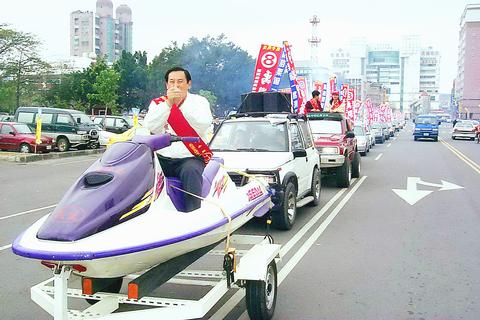Polls for local chiefs and councilors take place today to elect 319 local chiefs and 879 county and city councilors.
The elections for local chiefs may be the last of their kind to be held because the Ministry of the Interior has proposed terminating the polls in 2006 and appointing local chiefs and councilors in a bid to save public resources.

PHOTO: CHANG HSUN-TENG, TAIPEI TIMES
There are a total of 2,939 candidates registered for the elections, which include 852 candidates running for village, township and city heads and 1,992 candidates running for the county and city councilor seats.
The ruling DPP has nominated a total of 432 candidates for the elections, 166 of whom are local chiefs and 266 of whom are vying for councilor positions.
The KMT has nominated 324 candidates to run in the local head elections and 637 candidates to run in the county and city councilor elections.
The People First Party (PFP) has nominated 27 candidates to run in the elections for local heads and 267 candidates to run in the county and city councilor elections.
The newly-formed Taiwan Solidarity Union (TSU) nominated only two candidates for local chief positions and 39 candidates for the city and county councilor elections.
Political analysts predict that the KMT, which has long dominated local elections and developed a strong local voting system, might perform well in today's polls though the DPP might increase a substantial number of seats.
The KMT is estimated to win 175 out of the 319 seats for local chiefs and 400 out of the 879 seats in the city and county councilor elections.
Hsu Yang-ming (許陽明), deputy secretary-general of the DPP, said that the DPP hopes to see a 10 to 20 percent increase in the number of seats in the two elections.
The PFP said that it will do its best to have all of its candidates elected in the two elections.
The goal of the TSU is to see at least half of its candidates elected, according to Hsiao Kuan-yu (蕭貫譽), director of the TSU's public relations department.

TRAGEDY STRIKES TAIPEI: The suspect died after falling off a building after he threw smoke grenades into Taipei Main Station and went on a killing spree in Zhongshan A 27-year-old suspect allegedly threw smoke grenades in Taipei Main Station and then proceeded to Zhongshan MRT Station in a random killing spree that resulted in the death of the suspect and two other civilians, and seven injured, including one in critical condition, as of press time last night. The suspect, identified as a man surnamed Chang Wen (張文), allegedly began the attack at Taipei Main Station, the Taipei Fire Department said, adding that it received a report at 5:24pm that smoke grenades had been thrown in the station. One man in his 50s was rushed to hospital after a cardiac arrest

SAFETY FIRST: Double the number of police were deployed at the Taipei Marathon, while other cities released plans to bolster public event safety Authorities across Taiwan have stepped up security measures ahead of Christmas and New Year events, following a knife and smoke bomb attack in Taipei on Friday that left four people dead and 11 injured. In a bid to prevent potential copycat incidents, police deployments have been expanded for large gatherings, transport hubs, and other crowded public spaces, according to official statements from police and city authorities. Taipei Mayor Chiang Wan-an (蔣萬安) said the city has “comprehensively raised security readiness” in crowded areas, increased police deployments with armed officers, and intensified patrols during weekends and nighttime hours. For large-scale events, security checkpoints and explosives

A car bomb killed a senior Russian general in southern Moscow yesterday morning, the latest high-profile army figure to be blown up in a blast that came just hours after Russian and Ukrainian delegates held separate talks in Miami on a plan to end the war. Kyiv has not commented on the incident, but Russian investigators said they were probing whether the blast was “linked” to “Ukrainian special forces.” The attack was similar to other assassinations of generals and pro-war figures that have either been claimed, or are widely believed to have been orchestrated, by Ukraine. Russian Lieutenant General Fanil Sarvarov, 56, head

PUBLIC SAFETY: The premier said that security would be tightened in transport hubs, while President Lai commended the public for their bravery The government is to deploy more police, including rapid response units, in crowded public areas to ensure a swift response to any threats, President William Lai (賴清德) said yesterday after a knife attack killed three people and injured 11 in Taipei the previous day. Lai made the remarks following a briefing by the National Police Agency on the progress of the investigation, saying that the attack underscored the importance of cooperation in public security between the central and local governments. The attack unfolded in the early evening on Friday around Taipei Main Station’s M7 exit and later near the Taipei MRT’s Zhongshan